How to Hit Wedges and Turning Drives into Birdies
Discover to How to Hit Wedges, Master the Dreaded Midrange Golf Shot, and Get the Birdies You’ve Been Working For.
Can’t seem to wrap your mind around how to hit wedges from 50-70 yards?
Or maybe it’s just that this particular skill hasn’t made it to the top of your priorities list, yet.
In golf, we tend to put a lot of emphasis on our drivers, irons, and putters.
You may not think much about those midrange wedge shots until you’ve just hit a stunning drive on a par-four. Suddenly, you’re in the perfect position for a birdie; you just wish you had a little more confidence in your wedge play.
If you’re sick of squandering great opportunities because you haven’t mastered his shot yet, I’ve got great news for you.
It’s actually really easy to learn how to hit wedges with consistent accuracy. You just need to know how to:
- Select the right club
- Adjust your setup for a midrange shot
- Make one small change to your swing motion
I’m about to lay all that out for you. I’ll also share one of the biggest wedge mistakes, how to know if you’re making this mistake, and how to fix it.
Ready? Let’s grab a wedge and get started.
Club Selection for Midrange Wedge Shots
One of the greatest misconceptions about how to hit wedges is this idea that you need serious loft to pull off a midrange shot.
I see it all the time. Golfers grab their 58 and just rip it, figuring a high loft equals high wedge spin. (It doesn’t.) And what happens?
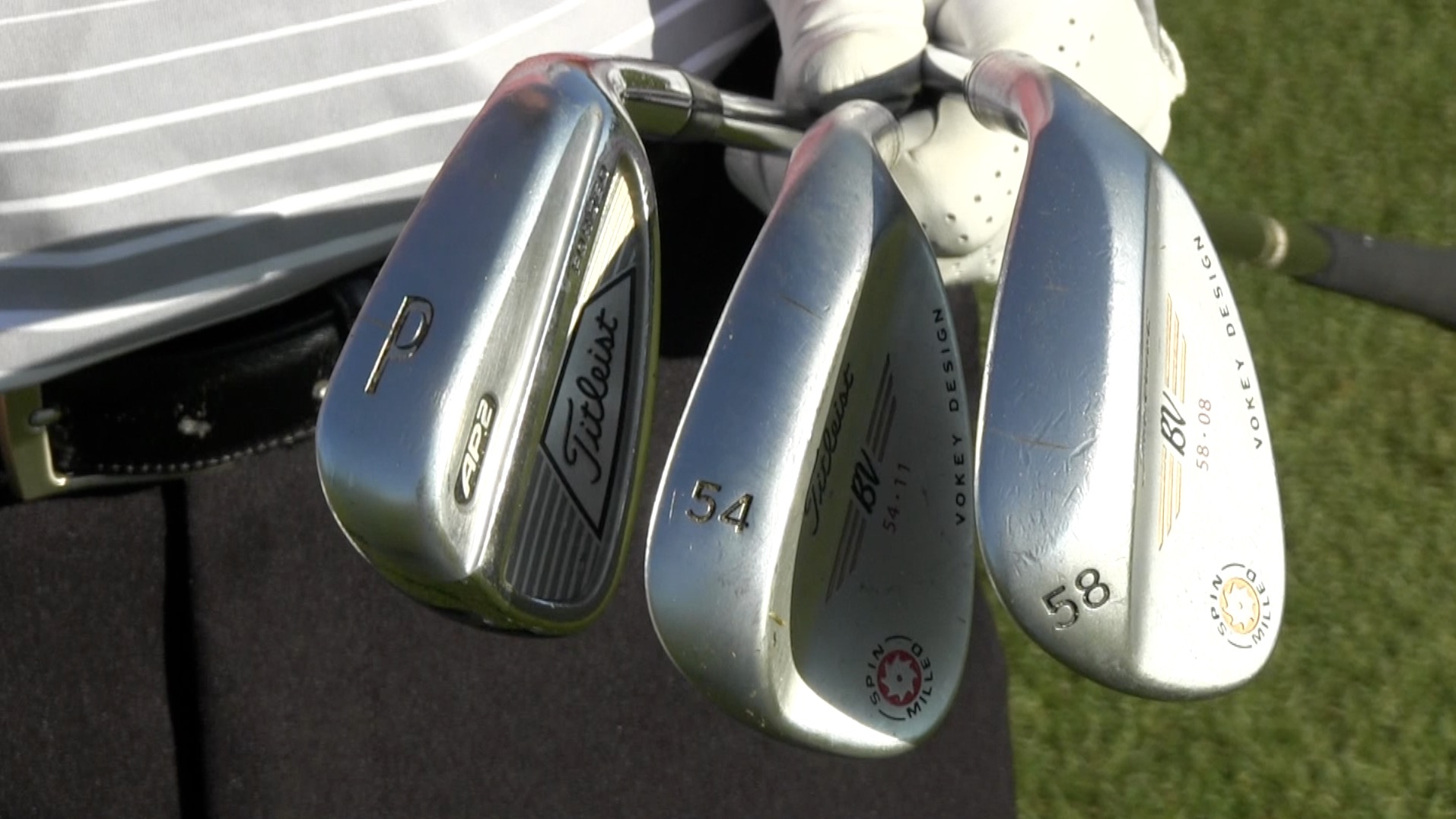
Their ball pops high up in the air and falls short of the green.
You see, between the extreme loft and the longer swing length, it’s much harder to control distance with your 58. You’ll see more success with a lower lofted wedge. I recommend grabbing your 54 for those midrange shots.
If you’re dealing with a lot of wind, you may even want to go down to a pitching wedge.
Once you’ve got the club in your hands, you’re ready to get set up.
How to Set Up for Your Wedge Shot
As is the case with any club, proper setup is a major component of how to hit wedges.
There are three elements of your wedge setup that I really want you to pay attention to.
Ball Position
You want the golf ball in the center of your stance for wedge shots. Slightly back in your stance works, too.
To find the sweet spot:
- Stand with your feet together and the ball positioned right between your feet.
- Get into your regular stance width by moving your lead foot forward and your trail foot back equal distances.
- The ball should now be in the center of your stance.
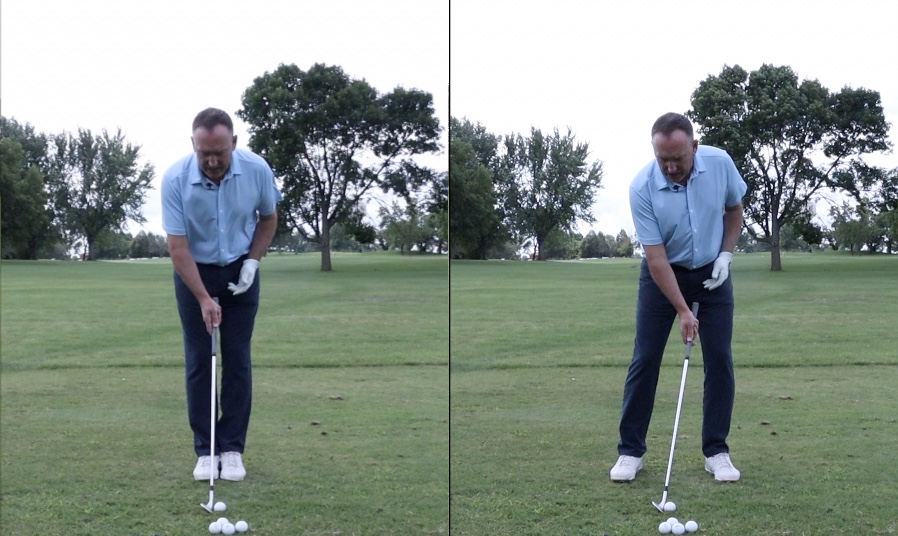
Once you’ve got the ball in the right spot, check your club shaft.
Shaft Lean
Allow for a slight forward lean (toward the target) in your club shaft. This helps you take a little more loft off of the clubface so you stay in control of your shot.
Weight in the Feet
If you’re already familiar with my instruction, you know how strongly I feel about the way you distribute weight in the feet before, during, and after your swing.
You’re probably also used to me saying that you want a 60/40 distribution at setup.
For midrange wedge shots, however, I recommend 70/30. That is, 70% of your weight should be in the lead foot and 30% should be in the trail foot at setup.
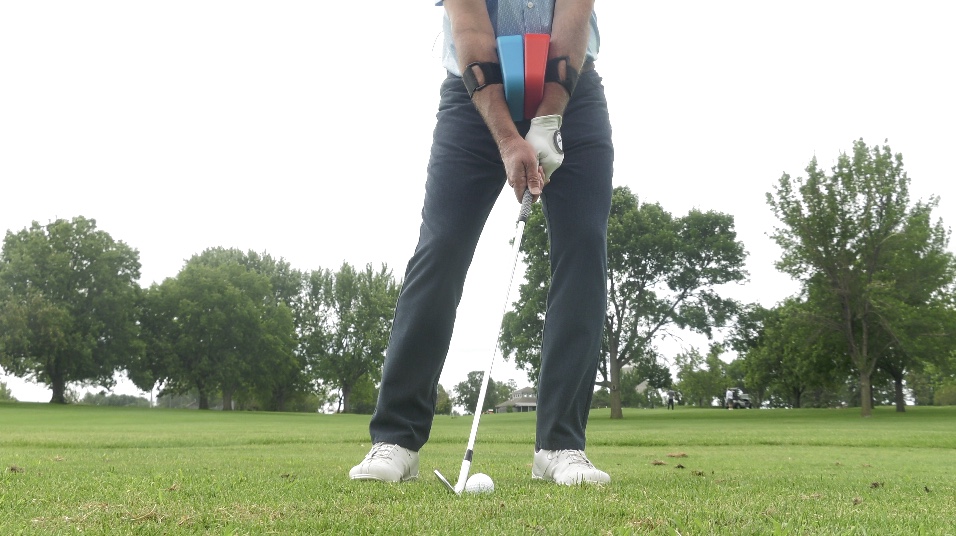
Once you’ve got your setup down, you’re ready to learn how to hit wedges. And you won’t even believe how simple this is.
The Ultimate Swing Tip for How to Hit Wedges
The most important thing to know when it comes to your swing motion for midrange wedge shots is this:
This is a finesse move. It’s not a power move.
If you spend a lot of time trying to pick up more yards at the driving range, your body has probably gotten into a power habit. For a lot of golfers, this means the arms and body move at different speeds throughout the swing.
But those midrange wedge shots require less acceleration and more measured control. This means you want your arms and body moving in unison. As your arms swing back, your body rotates with them.
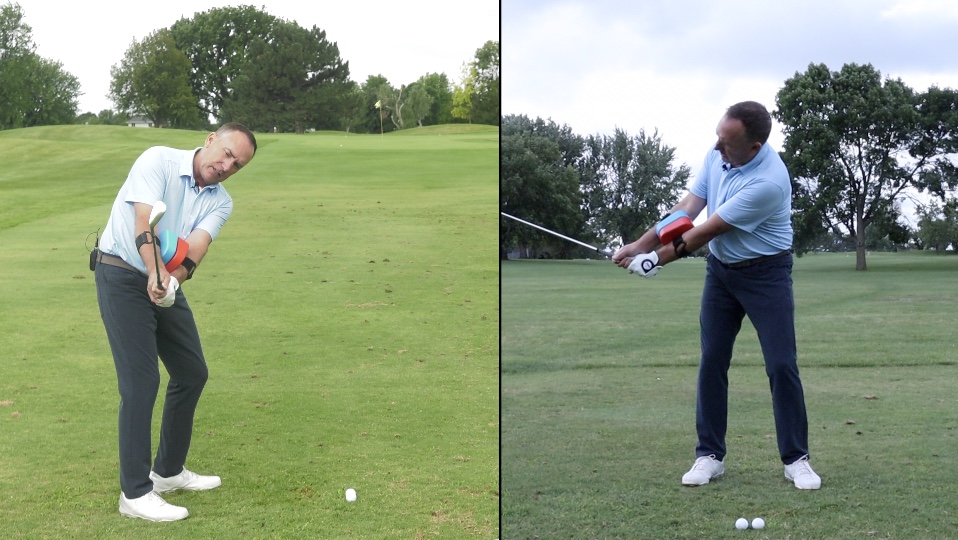
In other words, you’re looking for connectivity.
Now, if you want an easy way to work on getting the arms and body moving together, I recommend checking out the Vertical Line Swing Stacker. This is a training aid my team and I put together to make it easier for golfers to practice several essential skills, including this one.
(You learn about all the uses for this tool in our Vertical Line Swing Stacker review.)
The Stacker consists of two polyurethane squares (one red, one blue) attached to arm bands. You position the squares on your forearms just below the elbow, then connect them to one another by pressing their Velcro patches together.
Simply put, the Stacker gently forces you to stay connected throughout your swing. Practice your wedge shots several times with the armbands on, and you’ll soon find that connectivity becomes habit.

Now, let’s talk about the biggest misstep golfers make in their effort to learn how to hit wedges.
The Mistake You’re Probably Making
A lot of golfers rotate their forearms on the backswing. This forces the club to the inside and rotates the clubface open. And guess what happens when you swing down from this position.
That’s right. You hit it on the heel and you shank it.
Even typing that gave me chills.
The Fix
If you have a bad forearm rotation habit, the Stacker can help you catch it and correct it. I personally love using the Stacker when I’m teaching students how to hit wedges for this exact reason.
Here’s how it works.
You always want to put the blue Stacker on your trail forearm and the red one on your lead forearm. Then, when you’re practicing your wedge shots (don’t forget to connect the Stacker!), notice what the colors do in your backswing.
If you notice the red stacker rotating on top of the blue, you know your forearms are rotating and forcing the club inside.
To fix the habit, practice keeping the blue on top in the backswing. When you do this, you naturally keep the club in front where it belongs.
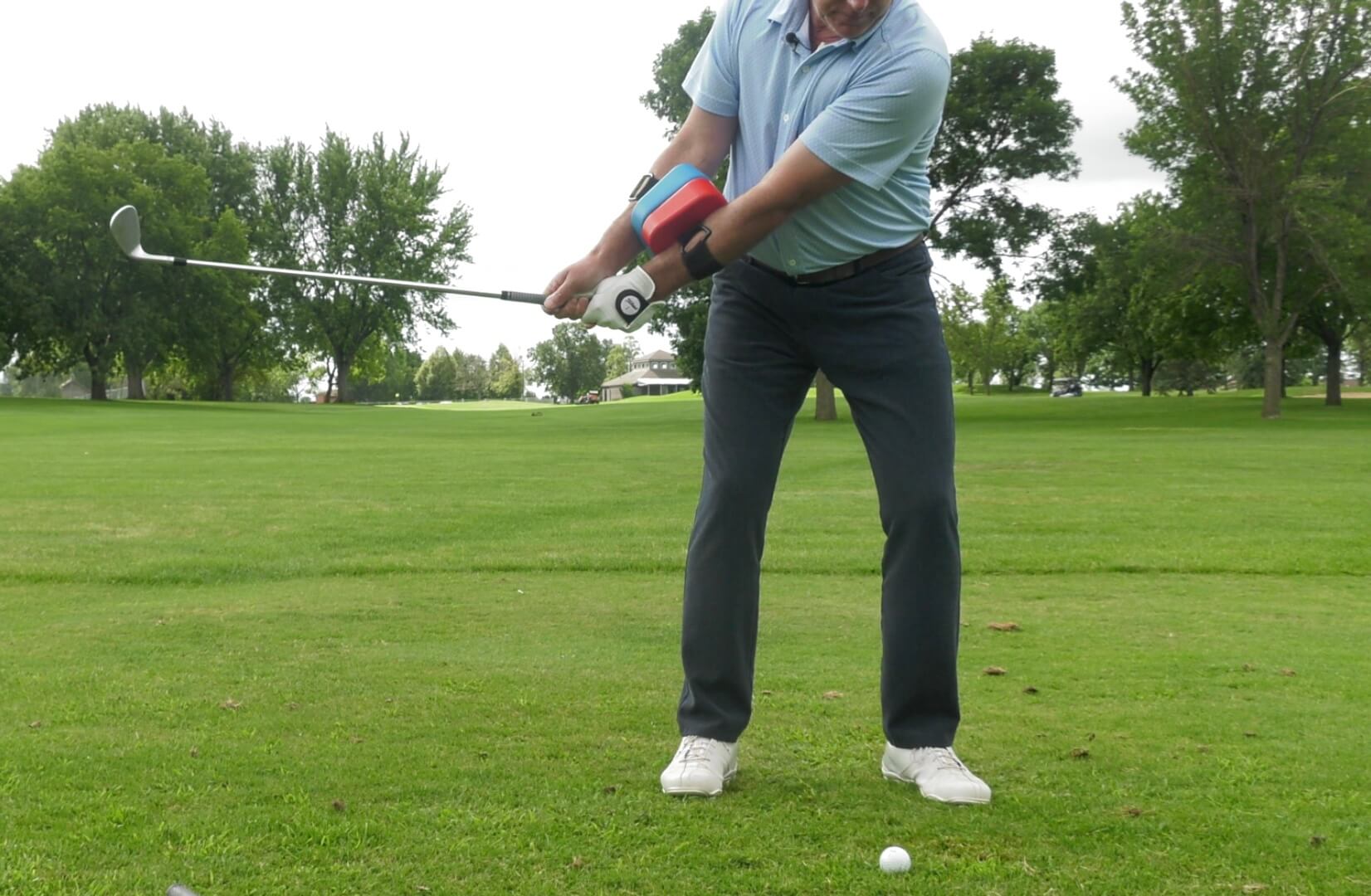
Now, you can practice this fix without the Stacker, but it will be harder. Forearm rotation is one of those small details that’s hard to feel and see in the split second when it happens. The bold colors of the stacker create a visual that’s hard not to notice, allowing you to make immediate corrections and see immediate improvement.
How to Hit Wedges: A Recap
Now that you know how to hit wedges—and how not to hit wedges—let’s round this all up in an easy checklist you can reference in the future.
For midrange wedge shots:
- Use a lower lofted wedge like a 54.
- Position the ball in the center of your stance or slightly back in your stance.
- Lean the club shaft forward just slightly.
- Put 70% of your weight in the lead foot, 30% in the trail foot.
- Allow your arms and upper body to move in unison throughout your swing.
- Avoid forearm rotation to keep your club in front.
If you can check off every item on this list, you can nail those midrange shots and start making more birdies.
Was This Helpful?
How often do you struggle with your wedges? Did you find the answers you were looking for?
Do you have any questions or tips of your own to share?
Join us in the comments and let us know what you think! And please let us know what else we can do to help you play better golf.
Want to discover more innovative golf tips and products the Vertical Line Swing Stacker? Be sure to check out vlsgolf.com!


Great advice today Todd. I’m a 7 hdcp and stress a great deal over this shot, my miss is a chunk. I have a tendency to play the ball too forward and end up taking a big divot…………
One of my biggest problems with this type of shot is bailing out on it, because I always fear hitting it over the green. I have a pretty good idea of the distances for my wedges, but always have that fear in my mind.
My biggest problem, overall though. is losing focus about halfway through a round. I start out good and then it just falls apart???
Will the stacker be a good trainer for the 20-30 yard pitches too? I hit full swings like someone who shoots low 80’s and short shots as bad as any beginner who ever played. I’ve played since I was 12 and I’m now 70, I’ve developed these yips in the last 5-6 years. Next to the green in two and the 4-5 more to get down. Usually whiff one or two 20 yarders every round. Help! I’m ready to quit! Used to shoot low 80’s, now 98-105 and it’s all in the short shots
Thanks Jim, nothing better than sticking a wedge close to the pin for a tap in birdie. Hope this and our other information is improving your game and bringing more enjoyment. Appreciate you posting…
Bruce,
Focus on developing a solid routine for this shot. This will help keep your mind in a consistent place. Check out this video for some guidance https://youtu.be/zw5T0ak83Bo
Glenn,
Great question, the short answer is yes. The Stacker can be used for a variety of shots, from driving to putting. For wedge shots we like the feeling of togetherness the stacker creates…this is a key for executing these shots. Hope that helps.
Love the video and super helpful tips. When California dries up, I look forward to trying this out. I ordered the stacker, but there was not any directions or videos or whatever included. Is there a link?
Sean,
Thank you for the purchase. I hope you are enjoying the product and it is helping your game. Here is the link for how to get the most out of your Stacker https://vlsgolf.com/blogs/news/vertical-line-swing-stacker-tutorials
Regarding mid-range wedge shots: if you start with 70% weight on left foot (for right handed golfers) and then take your backswing, are you still keeping 70% on the left foot? If not, what should be the percentages?
Clay,
Good question. There is a slight shift to the trail foot on these shots. It can vary, but a good rule of thumb is 80% on trail foot just before top of backswing. Hope that helps.
Yes, very good advice. I have an extreme problem with less than full shots and many time ruin many excellent drives because of it. I really struggle getting the ball in the air. Usually I skull the shot and hit a screaming line drive. My ball flight is never high anyway. I did notice you suggested 70% weight in the front foot on this shot. I am probably 70% back foot. The forearm rotation is another issue. Finally my divot really goes from outside in. If I do hit a flush shot here, it is usually pin high but pulled left off the green.
Hey; Todd sometimes you talk too much
Yes, Todd! 71 yo from Mobile, Al. I chunk & shank many short wedges. I’m probably rotating the club too much inside. I need to get the stacker to help all of my shots, including the Driver, Right?
Hi Greg, that could very well be the case. Here’s a great video to help explain what you mentioned: https://youtu.be/GcOUunxpz-g
Hope the info helps!
Ron,
Appreciate your feedback and honest input.
Todd,
I am a long time fan of your instruction and have purchased some of your training aids and the VLS book. I am a senior golfer, shooting in the high eighties and low ninety’s. I am struggling with shifting my weight to my front leg/foot for my irons and wedges and keeping it there throughout the swing. Any advice?
Thanks in advance.
Tony,
Thank you for the kind words. Two suggestions: watch this https://youtu.be/dx-H4ntMcGs
If you would like personalized coaching, contact us here https://www.vlscoaching.com/